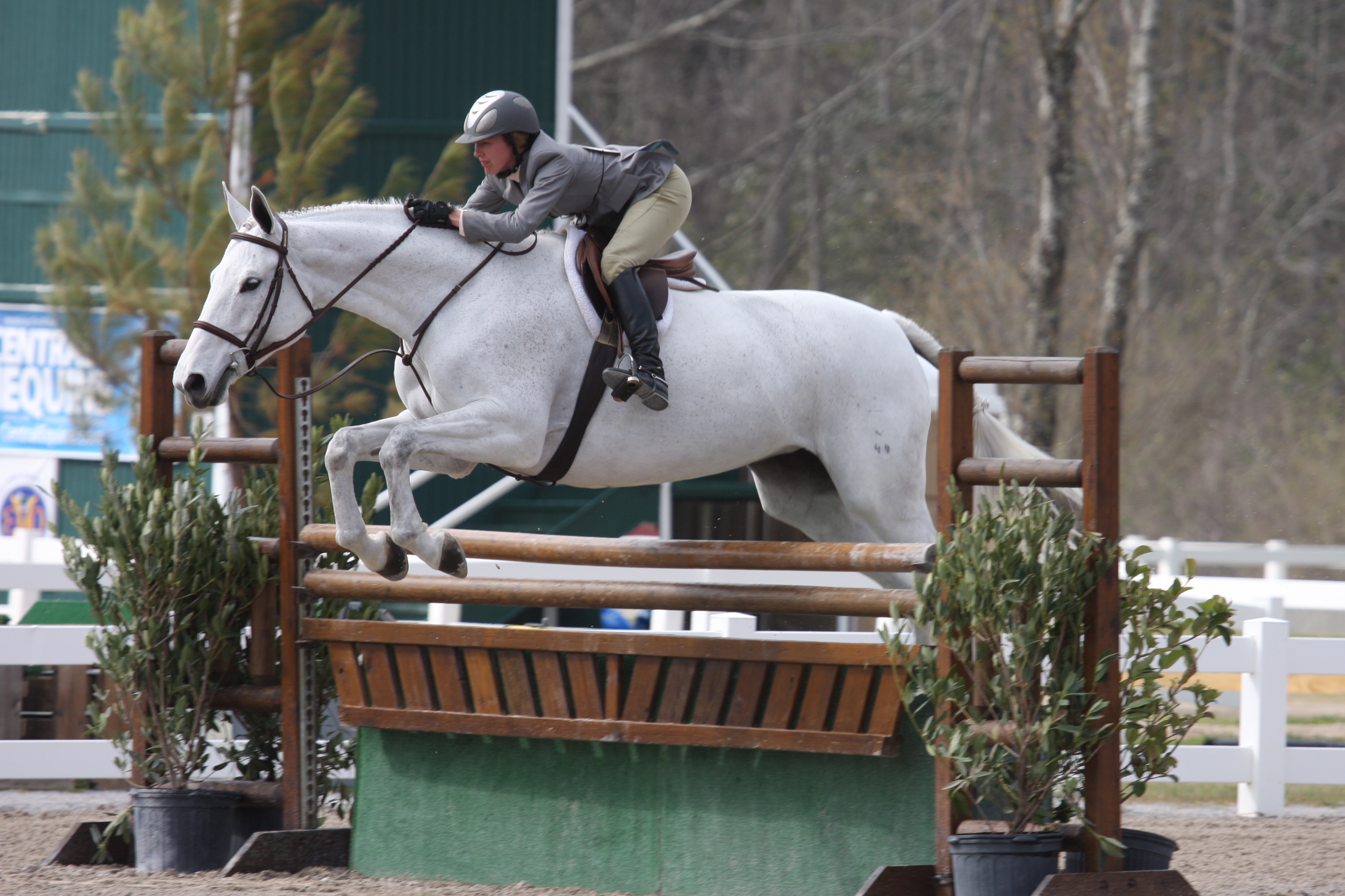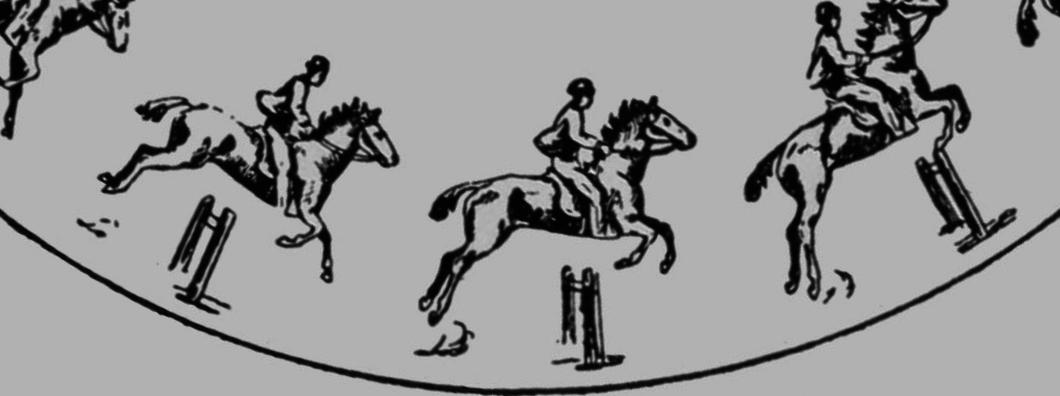|
Bascule (horse)
Bascule is the natural round arc a horse's body takes as it goes over a jump. The horse should rise up through its back, stretching its neck forward and down, when it reaches the peak of his jump. Ideally, the withers are the highest point over the fence. This is often described as the horse taking the shape of a dolphin jumping out of the water. Bascule can also refer more generally to the raising of the withers while the horse is in motion. Importance of bascule A horse with bascule is one with a "round" jump, while a horse with poor bascule may jump "flat" with his head in the air and his spine relatively straight. A hollowed back over the fence tends to prevent the animal from lifting his forearms very high, thus preventing the necessary tucking motion of his front legs to jump clear. Most naturally talented jumpers have good bascule. However, there are several very athletic horses that can jump great heights with considerably poor bascule due to sheer power. Some bascule ... [...More Info...] [...Related Items...] OR: [Wikipedia] [Google] [Baidu] |
|
|
Bascule ''
{{disambiguation ...
Bascule may refer to: * Bascule bridge, a moveable bridge with a counterweight that continuously balances the span in providing clearance for boat traffic * Bascule (horse), the arc a horse's body takes as it goes over a jump * Bascule light, a small navigational aid popular in Denmark up to the 18th century * Cecal bascule, a cause of large bowel obstruction * Teeterboard, a circus apparatus * Bascule the Teller, a character from the 1994 Iain M. Banks novel ''Feersum Endjinn ''Feersum Endjinn'' is a science fiction novel by Scottish writer Iain M. Banks, first published in 1994. It won a British Science Fiction Association Award in 1994. The novel is sometimes referred to as Banks' second science fiction novel no ... [...More Info...] [...Related Items...] OR: [Wikipedia] [Google] [Baidu] |
|
 |
Show Jumping
Show jumping is a part of a group of English riding equestrian events that also includes dressage, eventing, hunters, and equitation. Jumping classes are commonly seen at horse shows throughout the world, including the Olympics. Sometimes shows are limited exclusively to jumpers. Sometimes jumper classes are offered in conjunction with other English-style events. Sometimes, show jumping is but one division of a very large, all-breed competition that includes a very wide variety of disciplines. Jumping classes may be governed by various national horse show sanctioning organizations, such as the United States Equestrian Federation or the British Showjumping Association. International competitions are governed by the rules of the International Federation for Equestrian Sports. Hunters or jumpers Show jumping events have hunter classes, jumper classes and hunt seat equitation classes. Hunters are judged subjectively on the degree to which they meet an ideal standard of man ... [...More Info...] [...Related Items...] OR: [Wikipedia] [Google] [Baidu] |
 |
Show Hunter
The Hunter division is a branch of horse show competition that is judged on the horse's performance, soundness and when indicated, conformation, suitability or manners. A "show hunter" is a horse that competes in this division. Show hunters, ideally, show many qualities that were rewarded in the fox hunting field such as manners, fluid movement, and correct jumping style. They are shown in hunt seat style tack. Any breed can be exhibited, but at the highest levels they are usually of Warmblood or Thoroughbred type, though a hunter-style pony is also seen in youth classes. Some classes are restricted to horses of certain breeds or height. In the United States, show hunters are primarily exhibited over fences in various divisions, including Green Hunter, Working Hunter, Conformation Hunter and so on, with a few additional classes offered for horses shown in-hand or on the flat, known as "Hunter Under Saddle." In the United Kingdom, competition over fences is called "Working Hun ... [...More Info...] [...Related Items...] OR: [Wikipedia] [Google] [Baidu] |
|
Eventing
Eventing (also known as three day eventing or horse trials) is an equestrian event where a single horse and rider combine and compete against other competitors across the three disciplines of dressage, cross-country, and show jumping. This event has its roots in a comprehensive cavalry test that required mastery of several types of riding. The competition may be run as a one-day event (ODE), where all three events are completed in one day (dressage, followed by show jumping and then the cross-country phase) or a three-day event (3DE), which is more commonly now run over four days, with dressage on the first two days, followed by cross-country the next day and then show jumping in reverse order on the final day. Eventing was previously known as Combined Training, and the name persists in many smaller organizations. The term "Combined Training" is sometimes confused with the term "Combined Test", which refers to a combination of just two of the phases, most commonly dressage an ... [...More Info...] [...Related Items...] OR: [Wikipedia] [Google] [Baidu] |
|
 |
Bank (obstacle)
Various obstacles are found in competitive sports involving horse jumping. These include show jumping, hunter, and the cross-country phase of the equestrian discipline of eventing. The size and type of obstacles vary depending on the course and the level of the horse and rider, but all horses must successfully negotiate these obstacles in order to complete a competition. Fences used in hunter and eventing are generally made to look relatively rustic and natural. In jumping competition, they are often brightly colored and creatively designed. In hunter and jumper competition, obstacles are constructed to fall down if struck by the horse. In eventing, they are built to be solid, though for safety and to prevent rotational falls, certain elements may be designed to break away if hit. Arrowhead Also called chevrons, these fences are shaped like triangles, with the point facing towards the ground. They are generally very narrow, usually only a few feet wide. Arrowhead fences re ... [...More Info...] [...Related Items...] OR: [Wikipedia] [Google] [Baidu] |
|
Steeplechase (horse Racing)
A steeplechase is a distance horse race in which competitors are required to jump diverse fence and ditch obstacles. Steeplechasing is primarily conducted in Ireland (where it originated), the United Kingdom, Canada, United States, Australia, and France. The name is derived from early races in which orientation of the course was by reference to a church steeple, jumping fences and ditches and generally traversing the many intervening obstacles in the countryside. Modern usage of the term "steeplechase" differs between countries. In Ireland and the United Kingdom, it refers only to races run over large, fixed obstacles, in contrast to " hurdle" races where the obstacles are much smaller. The collective term "jump racing" or " National Hunt racing" is used when referring to steeplechases and hurdle races collectively (although, properly speaking, National Hunt racing also includes some flat races). Elsewhere in the world, "steeplechase" is used to refer to any race that invol ... [...More Info...] [...Related Items...] OR: [Wikipedia] [Google] [Baidu] |
|
 |
Hunt Seat
Hunt seat is a style of forward seat riding commonly found in North American horse shows. Along with dressage, it is one of the two classic forms of English riding. The hunt seat is based on the tradition of fox hunting. Hunt seat competition in North America includes both flat and over fences for show hunters, which judge the horse's movement and form, and equitation classes, which judge the rider's ability both on the flat and over fences. The term ''hunt seat'' may also refer to ''any'' form of forward seat riding, including the kind seen in show jumping and eventing. Hunt seat is a popular form of riding in the United States, recognized by the USHJA (United States Hunter/Jumper Association) and the United States Equestrian Federation, and in Canada. While hunt seat showing ''per se'' is not an Olympic discipline, many show jumping competitors began by riding in hunter and equitation classes before moving into the jumper divisions. Rider position The Hunt seat is al ... [...More Info...] [...Related Items...] OR: [Wikipedia] [Google] [Baidu] |
 |
Oxer
Various obstacles are found in competitive sports involving horse jumping. These include show jumping, hunter, and the cross-country phase of the equestrian discipline of eventing. The size and type of obstacles vary depending on the course and the level of the horse and rider, but all horses must successfully negotiate these obstacles in order to complete a competition. Fences used in hunter and eventing are generally made to look relatively rustic and natural. In jumping competition, they are often brightly colored and creatively designed. In hunter and jumper competition, obstacles are constructed to fall down if struck by the horse. In eventing, they are built to be solid, though for safety and to prevent rotational falls, certain elements may be designed to break away if hit. Arrowhead Also called chevrons, these fences are shaped like triangles, with the point facing towards the ground. They are generally very narrow, usually only a few feet wide. Arrowhead fences requir ... [...More Info...] [...Related Items...] OR: [Wikipedia] [Google] [Baidu] |
 |
Steeplechase (horse Racing)
A steeplechase is a distance horse race in which competitors are required to jump diverse fence and ditch obstacles. Steeplechasing is primarily conducted in Ireland (where it originated), the United Kingdom, Canada, United States, Australia, and France. The name is derived from early races in which orientation of the course was by reference to a church steeple, jumping fences and ditches and generally traversing the many intervening obstacles in the countryside. Modern usage of the term "steeplechase" differs between countries. In Ireland and the United Kingdom, it refers only to races run over large, fixed obstacles, in contrast to " hurdle" races where the obstacles are much smaller. The collective term "jump racing" or " National Hunt racing" is used when referring to steeplechases and hurdle races collectively (although, properly speaking, National Hunt racing also includes some flat races). Elsewhere in the world, "steeplechase" is used to refer to any race that invol ... [...More Info...] [...Related Items...] OR: [Wikipedia] [Google] [Baidu] |